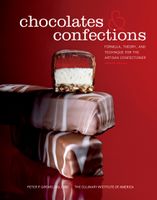Label
All
0
Clear all filters
🔥 Try our grilling cookbooks and save 25% on ckbk membership with code BBQ25 🔥
Technique: Caveats on Seeding
Appears in
By Peter Greweling and Culinary Institute of America
Published 2007
- Either small pieces of seed chocolate, such as pistoles, or larger pieces may be used. The smaller pieces cool and seed the chocolate faster, but the larger pieces have the advantage of easy removal after tempering. Regardless of which form of chocolate is used for seeding, it should be tempered chocolate. If untempered chocolate is used as seed in this technique, it will precrystallize the chocolate with unstable cocoa butter crystals, resulting in an inferior shine and snap and the formation of bloom during storage.
- If you are not using a single block, take care how much of the seed chocolate is added at any one time. When the bowl of chocolate is very warm directly from the melter, much more seed chocolate can be added at a time because the heat in the bowl of melted chocolate will melt all of the seeds. As the melted chocolate cools, however, less of the seed chocolate will melt and the danger of leaving unmelted chunks of chocolate in the bowl increases. When the temperature of the bowl of chocolate falls below about 32°C/90°F, seed chocolate is very slow to melt. At this temperature, if more seeding is required to temper the chocolate, very few pieces of seed chocolate should be added to provide the additional precrystallization that is required without leaving lumps in the bowl.
- It is not necessary to cool the chocolate much below 32°C/90°F when using the seeding method. Another major advantage of the seed method is that when performed properly, it introduces only Form-V crystals. Often during tempering, however, the temperature of the chocolate falls to a lower temperature than desired. If the temperature of the chocolate is too low, if the chocolate is overseeded, or if unmelted pieces of chocolate remain in the bowl, the chocolate must be carefully warmed. The chocolate may be warmed over a water bath, flashed on direct heat briefly, or heated in a microwave. Regardless of the method used to warm the chocolate, it must never exceed its maximum working temperature (32°C/90°F for dark chocolate; 30°C/86°F for milk or white chocolate) or the seed crystals will melt and the temper will be lost. After chocolate has been warmed, it should always be tested to verify that it is still in temper.
Become a Premium Member to access this page
Unlimited, ad-free access to hundreds of the world’s best cookbooks
Over 160,000 recipes with thousands more added every month
Recommended by leading chefs and food writers
Powerful search filters to match your tastes
Create collections and add reviews or private notes to any recipe
Swipe to browse each cookbook from cover-to-cover
Manage your subscription via the My Membership page
Best value
Part of
Advertisement
Related Recipes
-
-
-
-
Related Reference
-
-
-
-
Advertisement
The licensor does not allow printing of this title




